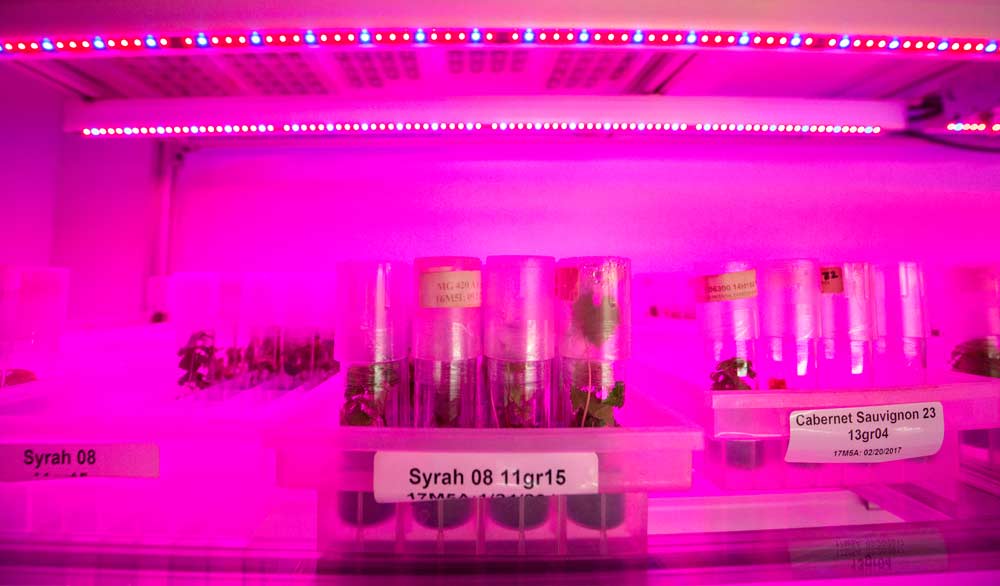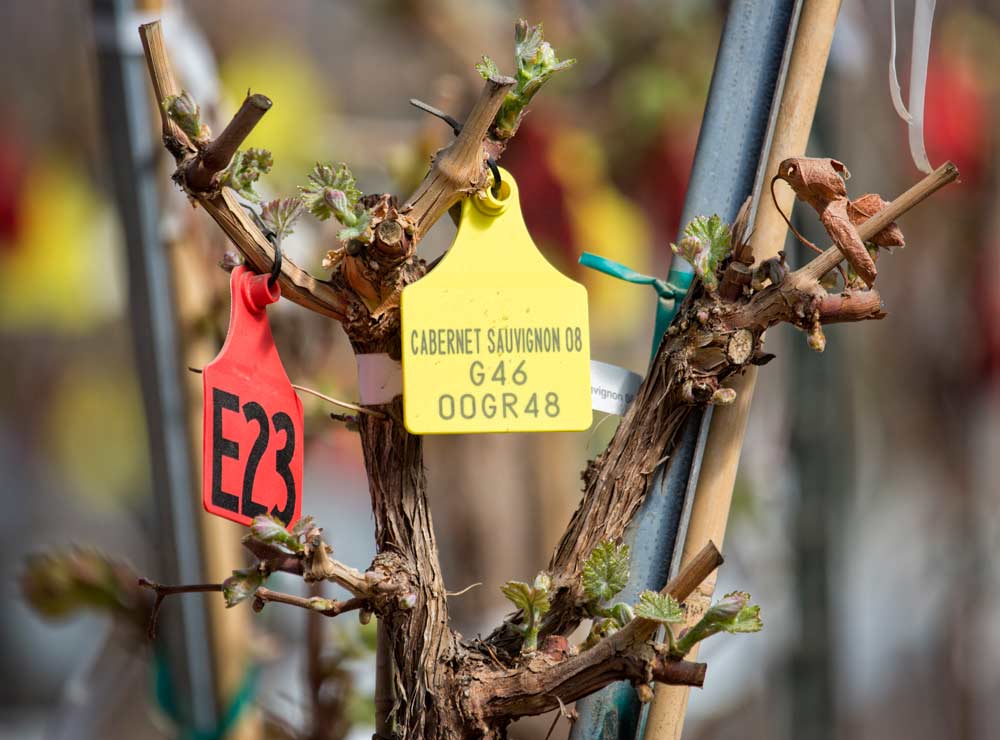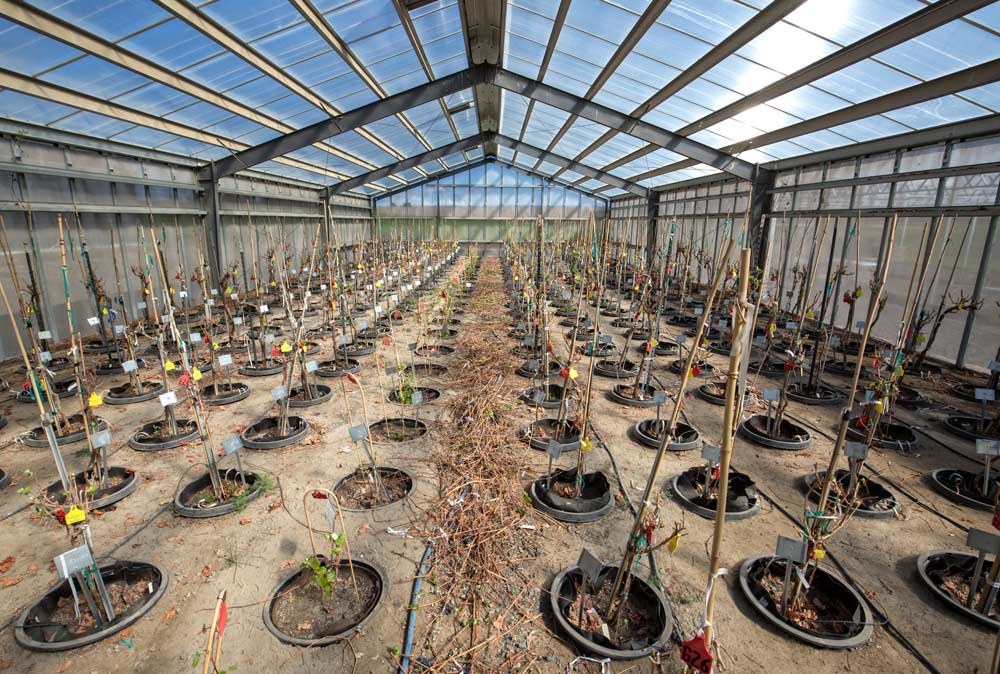
Syrah grape variety propagation at the Clean Plant Center Northwest tissue culture room at Washington State University’s research and extension campus in Prosser, Washington. The lab grows hundreds of samples, screening for diseases and other issues to eliminate any viruses from the plant before it is selected as a mother plant. (TJ Mullinax/Good Fruit Grower)
In Washington, imported grapevines must come with a certificate to show they are free of state-listed quarantine pests and diseases.
Oregon allows inspection and testing in lieu of certification.
Washington requires treatments against grape phylloxera and vine mealybug, which are not technically on the quarantine list but remain of concern.
Oregon requires additional testing of Xylella fastidiosa, the pathogen known for causing Pierce’s disease in wine grapevines, within 60 days of shipment.
The two states have different requirements for regulating pests and disease in grapevine nursery cuttings.
Idaho, meanwhile, has its own regulations, and legislative approval is required to change any of them.
However, all three approaches may align more closely in the years ahead, as Northwest nurseries, wine industry stakeholders and regulators wrap up a two-year project to begin to create a regional approach to grapevine certification in Washington, Oregon and Idaho.
Funded through a $200,000 federal grant, it’s part of a larger national effort to harmonize standards for “clean” plants across crops and states.
In the Northwest, key to that effort is streamlining quarantine pest lists and regulatory programs across the states.
A team of industry stakeholders and regulators have been working to compare programs, develop common pest lists, identify potentially acceptable testing methods and acceptable cultural mitigations for those common pests.
Naidu Rayapati, Washington State University plant pathologist and team member, said the effort marks the best example of industry, nurseries, universities and regulators working together to move the industry forward responsibly.
“To build this kind of very strong program and making sure we do things the right way is a benefit to the entire industry at large for the region,” he said. “And getting started early could give us input at the national level.”
Why clean plants?

A Cabernet Sauvignon mother plant at the Clean Plant Center Northwest facility at Washington State University extension campus on April 20, 2017, in Prosser, Washington. Chardonnay and Cabernet Sauvignon clones are some of the most popular requests by growers from the center. (TJ Mullinax/Good Fruit Grower)
Growers depend on healthy propagation materials to ensure the success and sustainability of their vineyards.
The importance of clean plant materials has become even more crucial in areas of rapid growth and expansion, such as Washington, where growers are increasingly top grafting scions onto existing rootstocks to avoid replanting a vineyard and speed the process of changing varieties.
The 2014 Farm Bill appropriated a minimum of $5 million annually for the National Clean Plant Network to ensure the availability of clean plant materials, as well as $2.5 million annually for safeguarding nurseries.
As part of the latter effort, some centers, with cooperation of industry and nursery insiders, are working to harmonize standards for clean plants across crops and states.
Work is well underway in the tree fruit and berry industries. Grapes are a little further behind.

All grape mother plants — more than 320 — propagated by the Clean Plant Center are cared for in this full greenhouse. (TJ Mullinax/Good Fruit Grower)
In the Northwest, wine grape growers and nurseries in Washington, Oregon and Idaho are working to streamline nursery certification processes and crop standards before attempting to work with other states.
California also is working to streamline requirements across its regions.
“Our industry is really motivated, and that’s what’s making it work. We’ve really got industry members driving it say, ‘We really need this,’” said Vicky Scharlau, executive director of the Washington Winegrowers. “If it were just the regulatory agencies pushing it, I don’t think it would have gone over as well. The benefit here is that industry gets that they have to drive it.”
Allen Holstein, viticulturist for Argyle Winery in Dundee, Oregon, and a member of the three-state advisory group, is pleased with the effort but also doesn’t believe it goes far enough.
“Certification is a starting point,” he said. “But they have to do more testing in addition to certification, and I think they ought to do more survey work, too.”
The party line right now, Holstein said, is clean plants, which is well and good if you don’t have virus in your neighborhood. “But if you do have virus in your neighborhood, and it is being vectored, then what’s the benefit of having clean plants?”
Of particular concern to him is red blotch virus, which is known to be spreading in Oregon vineyards. As far as he knows, Holstein doesn’t yet have it in his vineyard.
However, a neighbor planted an acre of Tempranillo vines from California in 2009, before the dangers were widely known, and now has the virus spreading from that block to others in his vineyard.
Scharlau also pointed to red blotch as a prime example of the need to ensure clean plants in the Northwest.
As Oregon growers replace infected vineyards, as Idaho’s industry expands and as Washington growers continue to replant vines at a rapid pace, the need for clean plants skyrockets.
“Granted, just because they’re clean today, doesn’t mean plants are going to be clean for the foreseeable future, but you have to at least start with a window of clean,” she said. “It’s really important for the sustainable source of clean plants for our sustainable future.”
She also stressed that the effort isn’t intended to just open borders to plant material that could introduce pests or pathogens.
“The message to growers is that it will be easier to buy and sell plants across state lines and making sure they understand what both the laws and regulations are for doing so — not just plants, but clean plants,” she said. •
A national effort
Since at least the 1950s, laboratories across the United States have performed diagnostic tests on plants, specifically for the purpose of therapeutically treating the plants or “cleaning” them. Most are run by universities, others by federal or state agriculture departments. As the science has gotten better, the laboratories have become more robust.
Then, in the 2008 Farm Bill, Congress recognized the importance of clean plant treatments by providing funding to streamline the various centers and create a process by which they can regularly discuss issues and share information.
Today, these centers, as part of the National Clean Plant Network, work to ensure clean materials for seven crops: berries, citrus, tree fruit, grapes, hops, sweet potatoes and roses.
The 2014 Farm Bill set goals for trying to define the boundaries of the network, but also to research ways to ensure plants remain clean once they’ve left a network foundation block or laboratory.
“There’s always been this question of, OK, now when you give the clean plant to a breeder or nurseryman or grower, is there something else we could do to provide some assurance the material remains clean as it moves through these systems?” said Erich Rudyj, national coordinator of the National Clean Plant Network, a division of the U.S. Department of Agriculture’s Animal and Plant Health Inspection Service or APHIS, in Riverdale, Maryland.
One initiative involves helping states to develop standards for clean stock in nurseries and to begin to share standards with other states that might have an interest in the same commodity.
Most are working regionally with neighboring states, and different crops are at different points in the process.
The fruit tree group was first, developing and testing standards. Berries then one-upped the tree fruit industry by developing a lexicon, or common language, for their industry, such as for nuclear stock, mother stock and through each generation beyond.
The process is far from easy, Rudyj said. For instance, crown gall is a problem for grapevines in some parts of the country but not others. That proves troublesome among nurseries or growers who believe they shouldn’t have to take extra measures that aren’t necessary in their region.
“At a national level, it’s all that much harder,” he said. “I think we can get there. I think we can establish basic standards that we have to meet and then augment those standards to address local variances, local conditions.”
The diagnostic work itself raises new issues. Advanced testing techniques reveal problems in plant materials that no one knew were there.
The question then isn’t just whether the problem is a pathogen, but whether it’s a pathogen that growers should be concerned about.
The take-home message to growers is that state and federal representatives are actively engaged with researchers and industry in these difficult discussions, Rudyj said. “And the end purpose of all of this: We hope to make it easier for industry to get what they need to have, in a condition that is reasonable for them to have, and in a timely manner.”
– by Shannon Dininny






Leave A Comment